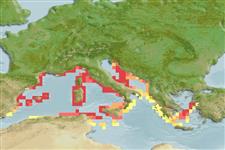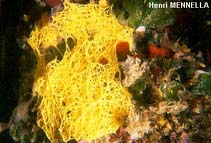Clathrina clathrus (Schmidt, 1864)
White Clathrina| Native range | All suitable habitat | Point map | Year 2050 |

|
| This map was computer-generated and has not yet been reviewed. |
| Clathrina clathrus AquaMaps Data sources: GBIF OBIS |
Classification / Names Common names | Synonyms | CoL | ITIS | WoRMS
Calcarea | Clathrinida | Clathrinidae
Environment: milieu / climate zone / depth range / distribution range Ecology
Sessile; depth range 0 - 20 m (Ref. 358). Subtropical
Distribution Countries | FAO areas | Ecosystems | Occurrences | Introductions
Mediterranean.
Length at first maturity / Size / Weight / Age
Maturity: Lm ? range ? - ? cm Max length : 10.0 cm TL male/unsexed; (Ref. 358)
Short description Morphology
Sponge being able to reach the size of 10 cm; interlaced tubes; of variable section (0.05 to 0.2 cm); osculum is located at the end of the broadest channel; color of a sharp yellow (Ref. 358).
Maximum Size: 10 cm. Description: Interlaced tubes, of variable section (0.05 to 0.2 cm), osculum is located at the end of the broadest channel; color of a sharp yellow (Ref. 358).
Life cycle and mating behavior Maturity | Reproduction | Spawning | Eggs | Fecundity | Larvae
Members of the class Calcarea are hermaphroditic. Life cycle: The zygote develops into either coeloblastula or amphiblastula larva (free-swimming) before settling down on a substrate where it grows into a young sponge.
Main reference
References | Coordinator | Collaborators
Göthel, H. 1992. (Ref. 358)
IUCN Red List Status (Ref. 130435: Version 2024-1)
CITES status (Ref. 108899)
Not Evaluated
CMS (Ref. 116361)
Not Evaluated
Threat to humans
Human uses
| FishSource |
Tools
More information
Trophic Ecology
Food items
Diet
Food consumption
Ration
Predators
Diet
Food consumption
Ration
Predators
Ecology
Population dynamics
Life cycle
Distribution
Human Related
Aquaculture profile
Stamps, Coins Misc.
Stamps, Coins Misc.
Outreach
References
Internet sources
BHL | BOLD Systems | CISTI | DiscoverLife | FAO(Publication : search) | Fishipedia | GenBank (genome, nucleotide) | GloBI | Gomexsi | Google Books | Google Scholar | Google | PubMed | Tree of Life | Wikipedia (Go, Search) | Zoological Record
Estimates based on models
Preferred temperature
(Ref. 115969): 17.4 - 19.5, mean 18.6 (based on 229 cells).
Price category
(Ref. 80766):
Unknown.



